Updates
CIOA at the Variety Showcase at the NAPB meeting in Hawai'i
On May 21st, members of the CIOA project took part in the Variety Showcase Hawai'i Island, an event organized by the Culinary Breeding Network as part of the National Association of Plant Breeders (NAPB) annual meeting. Plant breeders and seed growers, along with research scientists attending the NAPB conference exchanged information on new plant varieties and breeding methods, and partnered with local chefs so that attendees could sample the varieties for themselves! The event was partially funded by the HDA-SCBPG project “Expanding Markets of Specialty Crops for Input Substitution in Hawai'i”.
Students from the CIOA project displayed colorful rainbow 'Fantasia' carrots (available for sale from Ujaama Seeds), along with a poster and infographic about breeding for carrot texture, and a flyer on new CIOA varieties. Chefs from Rio Miceli restaurant made carrot hummus and chips with locally produced Walmea Butcher bacon! Avelina Gaston, Research Assistant at the University of Wisconsin-Madison, shared these photos of the booth and infographic:
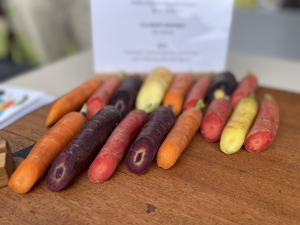
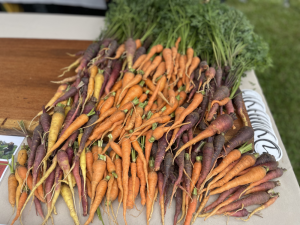
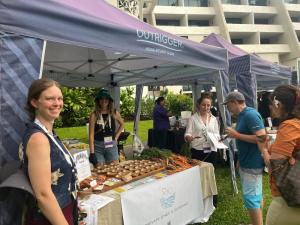
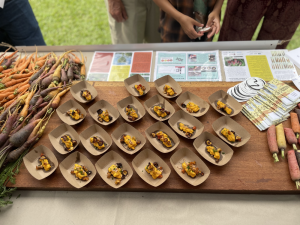

Summary of Accomplishments of CIOA2
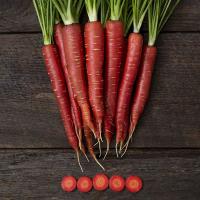 Cultivar development and release: More than 45 new populations were advanced with various combinations of priority traits including improved flavor, nutrient concentration, color, top growth size and vigor, Alternaria Leaf Blight (ALB) resistance, nematode resistance, and cavity spot resistance. A new source of northern root-knot nematode (Meloidogyne hapla) resistance was discovered in a purple CIOA breeding stock from Syria, and a sweet, mild-flavored orange advanced candidate for release in the CIOA project, F5367, was discovered to have exceptional cavity spot resistance. These sources of disease and pest resistance, as well as ALB resistance sources discovered in CIOA1 and gene sources for tall tops (TT) that enhance weed competition discovered in CIOA1 and CIOA2, are prominent in populations being developed and advanced. Orange breeding populations with improved flavor, increased carotene content, and ALB and cavity spot resistance advanced through participatory selection on two participatory farms and three research station trial sites (WI and two WA sites). Purple, red, and yellow colored breeding populations with improved flavor, texture, and robust agronomic production qualities were also advanced through research station trials. Seven new breeding populations were started – one orange and six novel colors. Successful production of seed to increase stock for widespread and larger scale trials of novel colored populations slated for release was accomplished. Eleven breeding pools combining ALB, TT, desirable flavor, and novel colors, which are polygenic traits important for organic growers, were derived by intercrossing elite selections from 700 open-pollinated carrots in a NIFA-SCRI project, and on-farm trialing of these breeding pools was initiated in CIOA2 to broaden the germplasm base of the CIOA project. Advanced selections were trialed by five organic seed companies and three advanced red and yellow populations (R6636, R6220, Y1246) targeted for use as novel-colored open-pollinated cultivars and parents for hybrid cultivars are being formally released in CIOA2. Dozens of new varieties and populations developed in CIOA1 and CIOA2 are slated for release during CIOA3. The CIOA open-pollinated red variety for fall production, 'Carnelian' was released by High Mowing Seed in 2022 (pictured left).
Cultivar development and release: More than 45 new populations were advanced with various combinations of priority traits including improved flavor, nutrient concentration, color, top growth size and vigor, Alternaria Leaf Blight (ALB) resistance, nematode resistance, and cavity spot resistance. A new source of northern root-knot nematode (Meloidogyne hapla) resistance was discovered in a purple CIOA breeding stock from Syria, and a sweet, mild-flavored orange advanced candidate for release in the CIOA project, F5367, was discovered to have exceptional cavity spot resistance. These sources of disease and pest resistance, as well as ALB resistance sources discovered in CIOA1 and gene sources for tall tops (TT) that enhance weed competition discovered in CIOA1 and CIOA2, are prominent in populations being developed and advanced. Orange breeding populations with improved flavor, increased carotene content, and ALB and cavity spot resistance advanced through participatory selection on two participatory farms and three research station trial sites (WI and two WA sites). Purple, red, and yellow colored breeding populations with improved flavor, texture, and robust agronomic production qualities were also advanced through research station trials. Seven new breeding populations were started – one orange and six novel colors. Successful production of seed to increase stock for widespread and larger scale trials of novel colored populations slated for release was accomplished. Eleven breeding pools combining ALB, TT, desirable flavor, and novel colors, which are polygenic traits important for organic growers, were derived by intercrossing elite selections from 700 open-pollinated carrots in a NIFA-SCRI project, and on-farm trialing of these breeding pools was initiated in CIOA2 to broaden the germplasm base of the CIOA project. Advanced selections were trialed by five organic seed companies and three advanced red and yellow populations (R6636, R6220, Y1246) targeted for use as novel-colored open-pollinated cultivars and parents for hybrid cultivars are being formally released in CIOA2. Dozens of new varieties and populations developed in CIOA1 and CIOA2 are slated for release during CIOA3. The CIOA open-pollinated red variety for fall production, 'Carnelian' was released by High Mowing Seed in 2022 (pictured left).
Variety trials on research stations and national participatory sites: On-farm and on-station trials were conducted in WI, WA, IN, and CA with participatory sites in OR, CO, VA, NY, ME, HI, and VT. Included were 12 advanced breeding populations, four check varieties, and selections from among 120 promising breeding populations evaluated for flavor, marketability, productivity, pigment content, and storage quality.
Advancing research on root microbiome interactions: A study to determine whether four carrot cultivars preferentially recruit Arbuscular Mycrrhizal Communities (AMF) under organic management was carried out on five organic vegetable farms and the University of Wisconsin (UW). Mean root colonization was significantly greater for one open-pollinated variety, which aligns with previous research, where modern varieties of several crops demonstrate a loss of response to colonization by AMF. This suggests that screening diverse genotypes may identify enhanced AMF colonization to be used either directly by farmers or to be included in breeding programs. AMF-associated soil proteins were not correlated to carrot cultivar at different farm sites but interesting interactions in the role of AMF in increasing soil proteins in more highly disturbed environments were observed. This can be characteristic of organic farms with reliance on tillage and cultivation indicating value in investigate the role of cultivar selection and AMF inoculation on soil aggregation in heavily tilled/cultivated phases of the organic crop rotation, and in intensive vegetable production.
Carrot roots were colonized by an abundant and diverse assortment of bacteria and fungi with greater diversity in organic management than conventional soils. Carrot genotype affected endophyte abundance in taproots and potential for individual isolates to affect seed germination, seedling growth, and ALB tolerance were evaluated. Benefits of endophytes on carrot growth were greatest when plants were subjected to ALB stress, highlighting the importance of environmental conditions and the potential functional role of endophytes. This study demonstrates that endophytes can play an important role in improving carrot performance and mediating stress caused by ALB. Studies evaluating carrot root microbiome effects on nitrogen scavenging and heavy metal uptake are underway.
Utilizing molecular markers to improve nematode resistance: Advanced CIOA2 experimental and promising populations were included in field trials for resistance to prevalent root-knot nematodes in California. Molecular marker evaluation found a major M. hapla resistance gene that is being fine-mapped to develop markers for breeders. Greenhouse tests were used to provide highly controlled screening conditions. Resistance traits for M. hapla, M. incognita and M. javanica were identified. Carrots were advanced for seed production to be included in genetic analysis, molecular marker evaluation, and breeding line development.
Diagnosis confirmed foliar diseases in trials: Motley dwarf was identified three years in Western and Central WA trials. ALB resistance was evaluated in Central WI. Promising CIOA2 breeding populations were identified where infection was high and wide variation in resistance was observed. Cavity spot resistance was tested for advanced CIOA2 breeding selections in infested fields in CA and WA and selections advanced for breeding.
Evaluating and improving carrot flavor, nutritional, and postharvest quality: Populations from CIOA2 varied in appearance, texture, flavor intensity, acidity, sweetness, and harshness. Overall flavor was positively correlated with sweetness but negatively correlated with harshness. A new source of crisp,succulent texture discovered in a nematode resistant breeding line hold particular promise for release. Carrot flavor evaluation from the 2020 growing season is in progress. CIOA2 populations slated for release were evaluated for flavor by researchers, students, and chefs.
Outreach: To inform growers and consumers about the positive environmental impact of organic production systems, and about carrot nutritional quality and flavor we continued to update and use this website developed through eOrganic served to disseminate research updates, timely articles, and related project events. Promotional brochures provided an overview of the project, and details about current research and research goals. One brochure was tailored for and shared with growers, the carrot industry, and researchers. A second version was developed for and shared with a general audience at CIOA-related events. We created a new scientific research poster about the project and presented it at related scientific focused events/conferences. The project reached approximately 800 growers, carrot industry members, researchers, food industry representatives, and consumers in this period. A project field sign was also created and installed at each project location field site so field visitors could clearly identify the project plots, project goals, work, partners, and funder, and visit the website for additional information. Each of the four project collaborators hosted public farmer field days in conjunction with each trial at the project research sites. Field days coincided with timing of trial evaluations. Public educational events featured diverse advanced varieties at the first virtual OSA WA research farm field day and the Farm to Flavor event in Madison, WI (300+ attendees in 2019).
Professional development: As part of education activities, undergraduate students, graduate students, and post-doctorates were trained in vegetable breeding, crop and seed production, disease protection and diagnosis, and soil science with a focus on organic systems as they participated in research projects critical to the COIA project. In 2019 alone four graduate students projects included CIOA research activities. This included one postdoc, Sahar Abdelrazek and graduate student Narda Silva at Purdue, and postdoc William Rolling and graduate student Erin Lalor at UW. One visiting undergraduate scholar from Colombia (Leidy Meija, University of Caldes, Colombia) at Purdue and two graduate student scholars from Pakistan (Aneela Nijabat, University of Sargodha; Nadia Riaz, Lahore College for Women University) at UW received training by conducting research projects for their respective theses. Project Co-PI Micaela Colley published on CIOA agronomic results in her PhD thesis at Wageningen University, NL. Prior research in CIOA1 included training five Ph.D. students, two M.S. students, three undergraduate theses, and 21 undergraduates. The long-term impact of this important educational element is to establish the next generation of researchers, Extension, and industry representatives with organic systems expertise. Publications and other outreach materials can be found on the Resources section of this website.
Funding

This project was funded by the Organic Research and Extension Initiative grant, part of the USDA National Institute of Food and Agriculture. Award # 2011-51300-30903; Award # 2016-51300-25721: CIOA 2- Carrot Improvement for Organic Agriculture With Added Grower and Consumer Valuel Award # 2021-51300-34900: Carrot Improvement for Organic Agriculture: Leveraging On-Farm and Below Ground Networks.

